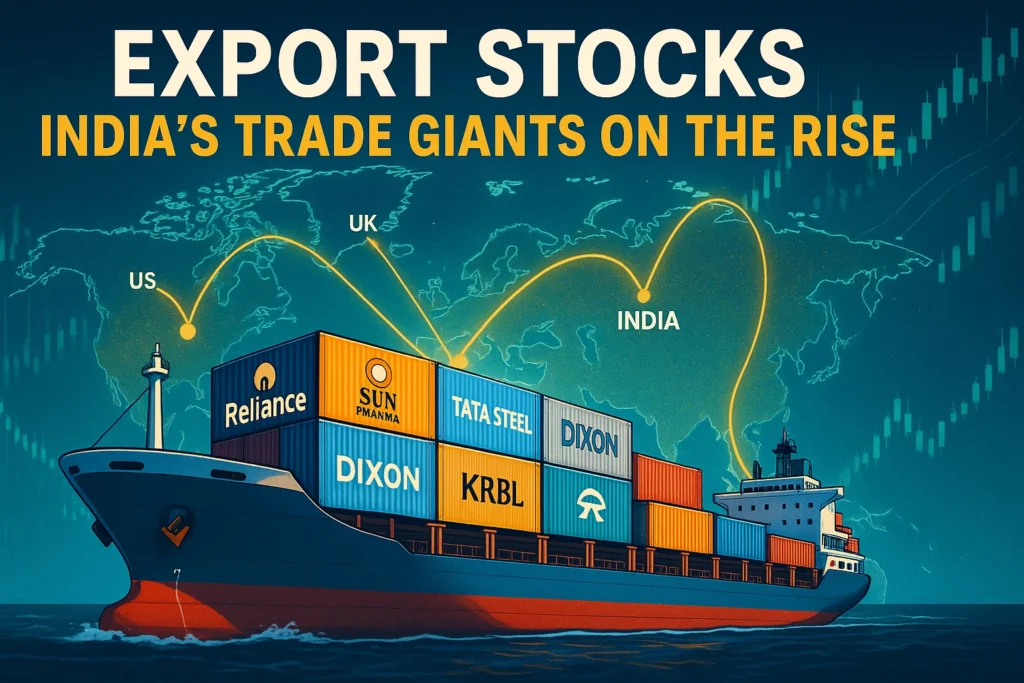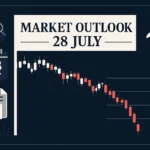Introduction: India’s Export Momentum and the Rise of Export Stocks
India’s export ecosystem is booming, driven by rapid growth across sectors like electronics, engineering, pharmaceuticals, and agri-products. In FY 2024-25, India recorded its highest-ever total exports—reaching US $825 billion, a 6.3% jump from the previous year. This stellar performance underscores a structural shift in India’s global trade position, with export-driven companies increasingly becoming wealth creators.
As the government doubles down on policy reforms, free trade agreements, and incentive schemes like the PLI, certain Indian corporates are uniquely poised to benefit. These export stocks—spanning diverse industries—are emerging as critical plays for investors eyeing global exposure through domestic equities.
In this blog, we explore the catalysts behind India’s export boom, deep-dive into the top sectors and companies leading the charge, and highlight key export stocks that are worth tracking.
What’s Driving the Boom in Export Stocks?
India’s recent export surge is not a one-off event—it’s rooted in structural reforms, sectoral incentives, and global supply chain realignments. As traditional and new-age industries pivot toward global markets, companies with a strong export focus are outperforming their peers, creating momentum in export stocks.
1. Government-Led Policy Push
- Production-Linked Incentive (PLI) schemes across electronics, pharma, and textiles are encouraging domestic champions to scale exports.
- Aggressive export promotion through missions like ‘One District, One Product’ and focused support to MSMEs is improving sectoral competitiveness.
- Export credit schemes, interest subvention, and port digitization are improving ease of trade.
2. Trade Agreements Fueling Market Access
- The recent India-UK Free Trade Agreement (FTA) eliminates or reduces tariffs across high-margin export verticals like textiles, basmati rice, pharma, and gems.
- Talks with the EU, Canada, and Gulf nations are progressing, offering India a diversified export footprint.
3. Sectoral Tailwinds
- Pharma is witnessing global demand for generics and contract manufacturing, particularly from the U.S. and Europe.
- Engineering goods are benefitting from infrastructure investments across developing nations.
- Smartphone and electronics exports are growing fast, with Apple, Samsung, and their suppliers ramping up India output for global markets.
4. China+1 Strategy
- Global corporates are diversifying away from China, giving Indian exporters a once-in-a-decade opportunity to become alternative manufacturing hubs.
- This shift is most evident in sectors like chemicals, auto components, textiles, and electronics—directly boosting the outlook for related export stocks.
With a perfect storm of demand, policy, and global realignment, Indian companies with international footprints are well-positioned to lead the next phase of export-led growth. For investors, this makes export stocks an attractive theme not just for short-term gains, but for long-term structural alpha.
Trade Catalysts & Policy Levers Boosting Export Stocks
India’s export growth is not just a cyclical recovery—it’s being powered by a combination of trade diplomacy, structural incentives, and strategic manufacturing shifts. These macro forces are amplifying the performance of key export stocks, especially in sectors aligned with global demand and trade facilitation.
1. Game-Changing Free Trade Agreements
- The India-UK Free Trade Agreement (FTA), signed in July 2025, removes duties on Indian exports like textiles, jewellery, footwear, and basmati rice—giving companies in these sectors a clear cost advantage in a high-margin market.
- Negotiations are also advancing with the EU, Australia, Canada, and the UAE, each offering access to major consumer markets and incentivizing companies to scale export capacity.
Impact on Export Stocks: Stocks like Welspun India, Page Industries, and KRBL could benefit significantly from tariff-free exports under these pacts.
2. Strategic Push into Defense Exports
- India has set a target of ₹50,000 crore (~US $6 billion) in defense exports by 2029.
- The country is now exporting missiles (e.g. BrahMos), drones, naval systems, and radar equipment to friendly nations.
Stock Spotlight: Public-sector stocks like BEL (Bharat Electronics Ltd.) and HAL (Hindustan Aeronautics) have seen a sharp uptick in order flows, making them rising stars among defense-oriented export stocks.
3. Infrastructure and Port Modernization
- Dedicated Freight Corridors (DFCs), improved port logistics, and inland connectivity are reducing turnaround times and making Indian goods more competitive.
- The government’s digitalization push—like ICEGATE, EDI-enabled ports, and e-invoicing—is streamlining export documentation.
Why It Matters: Faster delivery cycles enhance margins and reduce friction for export-heavy businesses, improving both their earnings outlook and stock attractiveness.
4. Sector-Specific Incentives
- PLI schemes in electronics, pharma, auto components, and solar modules are boosting both capacity and export volumes.
- Textile parks, medical device clusters, and electronics manufacturing hubs are being fast-tracked.
Export Stock Implications: Beneficiaries of these schemes—such as Dixon Technologies, Sun Pharma, and Bharat Forge—are witnessing not only revenue growth but margin expansion, reinforcing their value as long-term export stock bets.
With trade barriers falling, government backing rising, and Indian companies stepping up global competitiveness, the stage is set for a sustained export rally. The biggest beneficiaries? Investors positioned in well-chosen export stocks.
Sector Spotlight and Projections: Export Engines Powering Key Stocks
India’s export boom is not uniform—it is being led by specific sectors that are benefiting from strong global demand, supportive government policy, and increasing production capacity. A closer look at these sectors reveals which businesses are poised to dominate the next phase of export-led growth. This insight is critical for identifying high-potential export stocks.
Pharmaceuticals: Scaling Up for Global Demand
India has established itself as a major supplier in the global pharmaceutical supply chain, particularly in generic medicines and active pharmaceutical ingredients (APIs). The country currently exports pharmaceutical products worth approximately US $25 billion, with projections aiming for US $65 billion by 2030. Demand from the United States, European Union, and emerging markets continues to rise, especially for contract manufacturing and affordable therapies.
Key export stocks in this segment include Sun Pharma, which leads the Indian pharma export market, along with Dr. Reddy’s and Cipla, both of which have extensive international reach and regulatory approvals.
Engineering Goods: Leading the Manufacturing Edge
Engineering goods make up more than 25 percent of India’s total merchandise exports, supported by robust demand for steel, automotive components, and industrial machinery. India’s engineering exports are finding increased traction in Latin America, Africa, and Southeast Asia, aided by infrastructure spending and industrial expansion in these regions.
Notable export stocks in this category include Tata Steel and JSW Steel in the metals space, as well as Bharat Forge and Ashok Leyland in automotive components and commercial vehicles.
Textiles and Man-Made Fibers (MMF): Positioned for a Rebound
The textile sector, long considered a traditional strength for India, is now undergoing a modern revival. The India-UK Free Trade Agreement has created fresh momentum by eliminating tariffs on Indian textile exports. At the same time, rising demand for man-made fibers is opening new global markets. The sector is expected to grow from its current US $44 billion to over US $100 billion by 2030.
Top textile-focused export stocks include Welspun India, KPR Mill, and Page Industries, which benefit from strong retail brand tie-ups abroad. Trident and Vardhman Textiles are gaining ground with high-quality MMF products.
Electronics and Smartphones: Rapid Growth Driven by PLI
Electronics exports have seen exponential growth in recent years, led by smartphone manufacturing under the Production-Linked Incentive (PLI) scheme. From negligible levels just a few years ago, India’s electronics exports are now exceeding US $15 billion annually. Companies supplying to global majors such as Apple and Samsung are scaling up capacity for international shipments.
Key stocks to watch in this space include Dixon Technologies and Amber Enterprises, both of which serve as key contract manufacturers. Bharat Electronics Limited (BEL) also plays a dual role in consumer and defense electronics exports.
Agriculture: Expanding Reach in Global Food Supply
India continues to lead globally in the export of rice, spices, marine products, and sugar. With over US $53 billion in agri-export revenue in FY 2024, the country is meeting the growing needs of markets in Africa, the Middle East, and Asia. Government support for logistics, food parks, and sanitary regulations is helping to improve competitiveness.
Prominent export stocks in this sector include KRBL, the world’s largest basmati rice exporter. Other notable names include Avanti Feeds and Venky’s, which are building strong export bases in aquaculture and processed poultry.
These sectors are forming the backbone of India’s export expansion. Companies with strong international revenue exposure, sector-specific incentives, and scalable business models are well-positioned to drive future growth. As global trade patterns evolve, these businesses represent some of the most promising export stocks for long-term investors.
Companies to Watch: Top Export Stocks Leading the Charge
As India’s export economy expands, a growing number of companies are leveraging this momentum to capture global market share. These businesses combine strong product demand, competitive cost structures, and strategic positioning to generate substantial export revenues. For investors, these firms represent the most promising export stocks in the current market cycle.
Reliance Industries – Dominating Petroleum Exports
Reliance Industries stands out as India’s single largest exporter, contributing nearly 7 percent of the country’s total merchandise exports. By operating the world’s largest refinery complex and exporting petroleum and petrochemical products to more than 100 countries, the company has built a resilient global footprint. Its scale, integration, and product mix continue to drive export volumes, making Reliance a core component of any export-focused investment strategy.
Tata Steel – Engineering a Global Reach
Tata Steel continues to strengthen its position as a major exporter of value-added steel products. With manufacturing hubs in India, the UK, and the Netherlands, Tata Steel exports across Europe, Southeast Asia, and Africa. The company benefits from rising infrastructure demand and ongoing de-risking of China-centric supply chains. As a result, it remains one of the most dependable export stocks in the engineering and metals space.
Sun Pharma – Expanding India’s Pharmaceutical Footprint
Sun Pharmaceutical Industries has evolved into a global pharma leader, shipping products to over 100 countries. The company has focused on scaling its generics, specialty drugs, and API exports, especially to regulated markets like the United States and Europe. With strong R&D capabilities and consistent regulatory approvals, Sun Pharma is well-positioned to capture long-term growth in global healthcare demand.
KRBL – Leading India’s Agri-Export Push
KRBL has earned its place as the world’s largest exporter of basmati rice. By maintaining a strong brand in global retail markets and meeting stringent quality standards, KRBL continues to expand its customer base across the Middle East, Europe, and the U.S. The company’s performance aligns closely with the broader agricultural export boom, positioning it as a standout export stock in the food sector.
Dixon Technologies – Riding the Electronics Export Wave
Dixon Technologies has emerged as a key beneficiary of India’s electronics manufacturing surge. As a contract manufacturer for global brands, Dixon plays a central role in smartphone and consumer electronics exports. With the support of the PLI scheme and increasing exports to markets like the Middle East and Southeast Asia, Dixon offers investors access to one of the fastest-growing export segments.
Bharat Forge – Powering Industrial and Defense Exports
Bharat Forge has leveraged its expertise in precision engineering to become a top exporter of auto components and industrial systems. Recently, the company has expanded into defense exports, including artillery and aerospace components. With a diversified export base and new opportunities under India’s defense export strategy, Bharat Forge is strengthening its profile among high-potential export stocks.
These companies are not just responding to global demand—they are actively shaping India’s future as a global supplier. Investors looking to benefit from the country’s export momentum should focus on these firms, which combine scale, innovation, and a clear international strategy.
Risks and Challenges: What Could Impact Export Stocks?
While the outlook for export-driven companies remains strong, several external and domestic risks could impact performance. Understanding these challenges is essential for managing expectations and making informed investment decisions in export stocks.
| Risk Area | Description | Potential Impact on Export Stocks |
|---|---|---|
| Global Demand Slowdown | Economic slowdowns in key markets like the US, EU, or China may reduce orders. | Pharma, engineering, and textile exporters could face lower volumes or pricing pressure. |
| Geopolitical Tensions | Trade disruptions due to conflicts or sanctions (e.g. Red Sea crisis, EU tariffs). | Companies with heavy export reliance on specific regions may face logistics or regulatory challenges. |
| Currency Fluctuations | A strong rupee can reduce export competitiveness and earnings in foreign currency. | Margins of large exporters like Reliance or Sun Pharma may shrink if INR appreciates. |
| Raw Material Inflation | Rising input costs (e.g. steel, APIs, cotton) can erode profitability. | Sectors like textiles, metals, and agri-products may experience margin pressure. |
| Policy Uncertainty | Delay in trade deals or reversal of export incentives (e.g. MEIS, PLI issues). | Mid-cap exporters and small-scale units are more vulnerable to sudden policy shifts. |
| Infrastructure Gaps | Inadequate port, rail, and logistics infrastructure can slow delivery timelines. | Exporters in remote or non-coastal locations may lose out to better-placed rivals. |
| Compliance & ESG Norms | Stricter global norms on environment and labor practices could limit access. | Non-compliant companies may lose contracts or face bans in developed markets. |
Even the most promising export stocks are subject to these macro and operational risks. Investors should track not only company fundamentals but also global trade developments, policy changes, and sector-specific vulnerabilities.
Investment Conclusion: Export Stocks as a Long-Term Growth Theme
India’s export resurgence is more than just a short-term recovery—it reflects a structural transformation in the country’s manufacturing, policy environment, and global positioning. From pharmaceuticals and electronics to steel and agri-products, Indian companies are scaling their presence across global supply chains. This shift is creating sustainable growth opportunities for a new generation of export stocks.
As free trade agreements reduce market-entry barriers and government incentives drive production capacity, export-oriented businesses are improving both top-line growth and operating margins. Companies like Reliance Industries, Sun Pharma, Tata Steel, KRBL, and Dixon Technologies are already capitalizing on these trends, and they continue to reinvest aggressively to expand their global footprint.
For investors, this presents a compelling opportunity. By focusing on well-managed, fundamentally strong companies with a clear export strategy, one can gain exposure to global growth while investing in Indian equities. Moreover, diversifying across sectors—such as pharma, engineering, textiles, and electronics—can reduce risk and enhance portfolio resilience.
Going forward, tracking developments like trade agreements, currency movements, and export incentives will be key to identifying which export stocks are best positioned to outperform. In a world that is increasingly looking beyond China for its supply needs, India’s export champions stand to benefit the most.
FAQs on Export Stocks
1. What are export stocks?
Export stocks refer to shares of companies that earn a significant portion of their revenue from selling goods or services to international markets outside India.
2. Why are export stocks important for investors?
Export stocks offer exposure to global demand and foreign currencies, often making them more resilient to domestic slowdowns and capable of delivering diversified growth.
3. Which sectors contribute the most to India’s exports?
India’s top export sectors include pharmaceuticals, engineering goods, petroleum products, textiles, electronics, and agricultural commodities like rice and seafood.
4. How do government policies impact export stocks?
Policies such as Production-Linked Incentive (PLI) schemes, trade agreements, and export subsidies can directly influence the earnings potential of export-focused companies.
5. What are some leading export stocks in India?
Prominent export stocks include Reliance Industries (petrochemicals), Sun Pharma (pharma), Tata Steel (engineering), Dixon Technologies (electronics), and KRBL (agriculture).
6. Are export stocks affected by currency fluctuations?
Yes. A weaker Indian rupee usually benefits export stocks by improving revenue margins, while a stronger rupee may reduce competitiveness abroad.
7. How can trade agreements like FTAs impact export stocks?
Free trade agreements lower tariffs and expand market access, boosting demand for Indian goods and enhancing the profitability of companies with export exposure.
8. What are the risks involved in investing in export stocks?
Risks include global economic slowdowns, geopolitical instability, commodity price volatility, compliance with foreign regulations, and logistical disruptions.
9. How can investors identify strong export stocks?
Investors should look for companies with a consistent track record of export revenue, strong foreign customer bases, global certifications, and low dependency on a single region.
10. Are export stocks suitable for long-term investment?
Yes. Many export stocks operate in structurally growing sectors and benefit from global diversification, making them strong candidates for long-term portfolios.
Related Articles
India–UK FTA Deal Explained: Key Sectors & Stocks to Watch
Luxury Housing Boom: Real Estate Stocks to Watch in 2025
How to Read Quarterly Results: A Beginner’s Guide to Earning Reports






